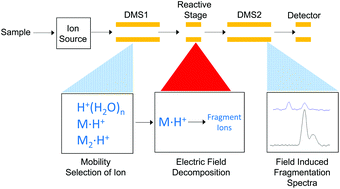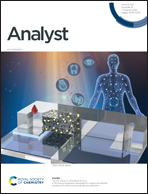Field induced fragmentation spectra from reactive stage-tandem differential mobility spectrometry†
Abstract
A planar tandem differential mobility spectrometer was integrated with a middle reactive stage to fragment ions which were mobility selected in a first analyzer stage using characteristic compensation and separation fields. Fragmentation occurred in air at ambient pressure of 660 Torr (8.8 kPa) with electric fields of 10 to 35 kV cm−1 (E/N of 52 to 180 Td) between two 1 mm wide metal strips, located on each analyzer plate between the first and second mobility stages. Field induced fragmentation (FIF) spectra were produced by characterizing, in a last stage, the mobilities of fragment ions from protonated monomers of 43 oxygen-containing volatile organic compounds from five chemical classes. The extent of fragmentation was proportional to E/N with alcohols, aldehydes, and ethers undergoing multiples steps of fragmentation; acetates fragmented only to a single ion, protonated acetic acid. In contrast, fragmentation of ketones occurred only for methyl i-butyl ketone and 2-hexanone. Fragment ion identities were supported by mass-analysis and known fragmentation routes and suggested that field induced fragmentation at ambient pressure can introduce structural information into FIF spectra, establishing a foundation for chemical identification using mobility methods.



 Please wait while we load your content...
Please wait while we load your content...